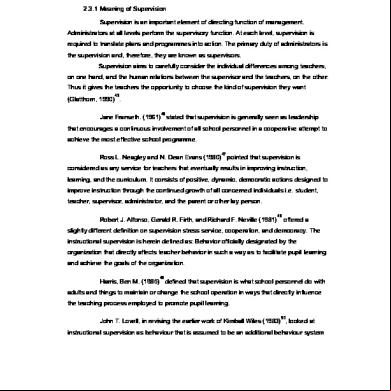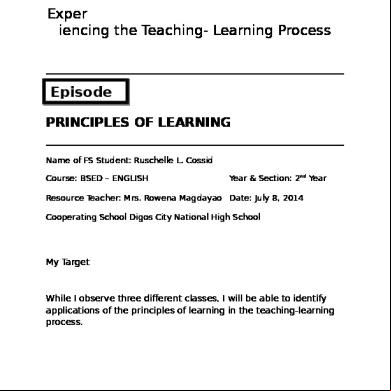Clinical Supervision 725643
This document was ed by and they confirmed that they have the permission to share it. If you are author or own the copyright of this book, please report to us by using this report form. Report 3b7i
Overview 3e4r5l
& View Clinical Supervision as PDF for free.
More details w3441
- Words: 1,492
- Pages: 46
Why Classroom Supervision? The quality of a SCHOOL is almost directly proportionate to the quality of classroom INSTRUCTION given in that school; The quality of classroom instruction given in a school is very much dependent upon the quality of the TEACHERS who teach in that school; The quality of performance of the teachers in the classroom is often related
How can we improve teacher’s performance and the quality of classroom teaching and learning?
•What’s happening inside the classroom? •What are students’ learning? •How are teachers’ teaching? •Should you enter or should you stay away? •What should you do once you enter? •How do you discover what is really going on between teacher and students?
HISTORY OF SUPERVISION IN THE PHILS. (RUIZ 1972)
1900 - 1924
Largely inspection and its chief purpose was CONTROL. Supervision was conducted by municipal, provincial officials or Local School Board.
1925-1941
Shift in authority, from municipal officials to academic supervisors. Emphasis was on Specialization. Supervisors decided on what to be taught to whom.
1946-1969
Supervision was described as democratic process. Supervisors established greater rapport with teachers and assisted them to improve classroom performance.
1970 to present
Cogan and Gold hammer experimented with Collaborative supervision and gave birth to a process of CLINICAL SUPERVISION.
CLINICAL SUPERVISION It can be defined as the type of instructional supervision which draws its data from focused observation of a previously planned class and which involves face-to-face interaction between supervisor/principal and teacher in order to improve the quality of instruction.
Clinical Supervision is more democratic, more teachercentered and more interactive since content, time and places are mutually
POST- CONFERENCE EVALUATION POST OBSERVATION CONFERENCE WITH THE TEACHER ANALYZING AND INTERPRETING THE OBSERVATION AND DETERMINING CONFERENCE APPROACH
OBSERVATION OF CLASSROOM INSTRUCTION
PRE-OBSERVATION CONFERENCE WITH THE TEACHER
Step 1
a. Purposes of PreObservation Conference
Preobservation conference • 1. Confirming and with the Nurturing the Teacherteacher Supervisor Relationship • 2.Fluency
• 3.Rehearsal • 4.Revisions • 5. Agreement
Step 1 Preobservation conference with the teacher
b. The principal will conduct a conference in which the teacher will:
a. describe the lesson to be observed. b. describe what he will be doing during the lesson.
Step 1
c. Describe expected Preobservation student behaviors. conference with the d. Predict problems, teacher rough spots, weak points, concerns, etc.
e. Agree with Prethe observation conference observer on with the teacher the focus of observation Step 1
.
Step 1
f. Agree with the
observer on the Preobservation schedule of the observations and the conference lesson to be with the teacher observed. g. Agree upon the observer’s role(What will be observed and what data will be collected.)
Step 1 Preobservation conference with the teacher
h.
Agree with the observer on the time for post observation conference.
Step 1
c. Pre-observation Tool
Instructional Supervision Form 1 Prescribed by DepED
Preobservation According to Goldhammer, conference during the pre-observation with the conference it would be helpful for both teacher and observer to teacher
anticipate rough spots or problem areas during the pre-observation conference but this is not stipulated in IS Form 1.
Step 2
Supervisor observes Observation the class so that he of Classroom or she may analyze it Instruction with the teacher afterward. Today’s data are employed as a source of tomorrow’s agenda for supervision.
Step 2 Observatio n of Classroom Instruction
TECHNIQUES
a. Observe in a manner that does not interrupt instruction.
TECHNIQUES Step 2 b. Record data Observatio n of as instruction Classroom takes place Instruction (selective verbatim).
Step 2
Observatio n of Classroom Instruction
TECHNIQUES c. Record what you see or hear.
Step 2 Observatio n of Classroom Instruction
TECHNIQUES
d. STAR observation/ recording recommended.
Step 2 Observatio n of Classroom Instruction
TECHNIQUES e. Do whatever is possible to make the observation a non-threatening experience.
Step 3 Analyzing and Interpreting the Observation and Determining Conference Approach
PURPOSE: 1.Analysis makes observational data intelligible and manageable.
Step 3
Analyzing and Interpreting the Observation and Determining Conference Approach
PURPOSE: 2. Plan the management of the supervision conference to follow – that is, to determine what issues to treat, which data to cite, what goals to aim for, how to begin, where to end, and who should do what.
Step 3
Analyzing and Interpreting the Observation and Determining Conference Approach
The principal leaves the classroom with the recorded observations and seeks solitude in an office or corner to study the information.
How to prepare Analyzing for the and conference? Interpreting the a.From selective Observation and verbatim Determining recorded, Conference Approach make a STAR. Step 3
Step 3 Analyzing and Interpreting the Observation and Determining Conference Approach
How to prepare for the conference? b. Identify behavior to be maintained. c. Identify behavior to be changed.
Step 3
Analyzing and Interpreting the Observation and Determining Conference Approach
How to prepare for the conference? d. Prepare strategies for the post conference. e. Be sure to identify positive points. f. It may be helpful to have someone else help analyze the data if someone is available.
Step 3 Analyzing
and Interpreting the Observation and Determining Conference Approach
How to prepare for the conference? g. Analyze and understand today’s teaching in order to modify tomorrow’s teaching.
Step 3
Analyzing and Interpreting the Observation and Determining Conference Approach
How to prepare for the conference?
h. After analyzing observational data, make decision about how supervision conference should be conducted.
Step 3
Analyzing and Interpreting the Observation and Determining Conference Approach
How to prepare for the conference? i. Determine the interpersonal approach to use with the teacher in the post conference.
Step 4
Post -observatio n Conference with the teacher
Post Conference - is where the hard work of supervision bears fruit. According to Covey, it is the win-win area.
Step 4
Post -observatio n Conference with the teacher
Consider the following:
1.Place 2.Time 3.Strategy 4.Attitude 5.Listening 6.Be positive
a. Establish rapport. Step 4 b. Listen more and talk Post less. -observatio *Getting the teacher to n talk during the post conference is an art. Conference * The more the teacher with the enters into the discussion, teacher analyzes the class observed and begins to criticize her/his own performance, the better.
Step 4
Post -observation Conference with the teacher
c.
Assist the teacher analyze the lesson by asking questions like: * Were the objectives realized? * What went well? What were the indicators to your realization? *What factors cause some problem to arise? * In what part of the lesson did your pupils find the difficulty? What did you do to solve the problem?
Step 4
Post -observatio n Conference with the teacher
d. Provide positive to the teacher. Point out the strengths and commend teacher for whatever innovation, effective strategies employed. e. Do not tell teacher what to do rather assist him/her to realize what could be done. Do away with prescribing what to do. f. Finally plan for improvement for next visit.
Step 4 Post -observati on Conferenc e with the teacher
Or Use Instructional Supervision Form 2 Use approaches that strengthen a teacher’s capacity for greater reflections, and self reliance in making improvements in classroom teaching and learning. The post conference is held to discuss the analysis of the observation and finally produce a plan for instructional improvement.
Step 5 Post – Conference Evaluation
• Critique of previous four steps. • There is not only supervision of teaching but also supervision of supervision. • Time to review whether the format and procedures from pre-conference to postconference were SATISFACTORY and whether revisions might be needed before repeating the sequences. • Need not be a formal session.
Step 5 Post – Conference Evaluation
• Can be a brief discussion.
a. Between Teacher and Principal *What was valuable in what we have been doing? *What was of little value? * What changes could be suggested?
Step 5 Post – Conference Evaluation
• Can be a brief discussion. b. Between Principal and Supervisor A conference between the principal and the supervisor to assess the conferencing skills used. Analysis of the supervisory conference to improve supervisory practices.
Step 5 Post – Conference Evaluation
*
Indicate that principal and teacher are both involved in the improvemen t efforts.
CRITERIONREFERENCED INSTRUCTIONAL SUPERVISION STRATEGY (CRISS)
Criterion-Referenced Instructional Supervision Strategy * an alternative to : -“inspection”, -“coercion”, -“prescription type” of supervision * CRISS is based on the assumption that the prime reason why a teacher is in the classroom is to effect desirable
Criterion-Referenced Instructional Supervision Strategy
• The intended change in the learner can be considered the “criterion” by which the teacher can be assessed in the adequacy of his efforts.
Criterion-Referenced Instructional Supervision Strategy
• Focus of CRISS : - is what happens to the learners as the consequence of what the teacher does • CRISS is designed to help teachers grow in: - self-direction - self-confidence - professional maturity
In life what really matters is NOT the position you hold but the SERVICE you do for others, whether you are a leader or a mere follower.
How can we improve teacher’s performance and the quality of classroom teaching and learning?
•What’s happening inside the classroom? •What are students’ learning? •How are teachers’ teaching? •Should you enter or should you stay away? •What should you do once you enter? •How do you discover what is really going on between teacher and students?
HISTORY OF SUPERVISION IN THE PHILS. (RUIZ 1972)
1900 - 1924
Largely inspection and its chief purpose was CONTROL. Supervision was conducted by municipal, provincial officials or Local School Board.
1925-1941
Shift in authority, from municipal officials to academic supervisors. Emphasis was on Specialization. Supervisors decided on what to be taught to whom.
1946-1969
Supervision was described as democratic process. Supervisors established greater rapport with teachers and assisted them to improve classroom performance.
1970 to present
Cogan and Gold hammer experimented with Collaborative supervision and gave birth to a process of CLINICAL SUPERVISION.
CLINICAL SUPERVISION It can be defined as the type of instructional supervision which draws its data from focused observation of a previously planned class and which involves face-to-face interaction between supervisor/principal and teacher in order to improve the quality of instruction.
Clinical Supervision is more democratic, more teachercentered and more interactive since content, time and places are mutually
POST- CONFERENCE EVALUATION POST OBSERVATION CONFERENCE WITH THE TEACHER ANALYZING AND INTERPRETING THE OBSERVATION AND DETERMINING CONFERENCE APPROACH
OBSERVATION OF CLASSROOM INSTRUCTION
PRE-OBSERVATION CONFERENCE WITH THE TEACHER
Step 1
a. Purposes of PreObservation Conference
Preobservation conference • 1. Confirming and with the Nurturing the Teacherteacher Supervisor Relationship • 2.Fluency
• 3.Rehearsal • 4.Revisions • 5. Agreement
Step 1 Preobservation conference with the teacher
b. The principal will conduct a conference in which the teacher will:
a. describe the lesson to be observed. b. describe what he will be doing during the lesson.
Step 1
c. Describe expected Preobservation student behaviors. conference with the d. Predict problems, teacher rough spots, weak points, concerns, etc.
e. Agree with Prethe observation conference observer on with the teacher the focus of observation Step 1
.
Step 1
f. Agree with the
observer on the Preobservation schedule of the observations and the conference lesson to be with the teacher observed. g. Agree upon the observer’s role(What will be observed and what data will be collected.)
Step 1 Preobservation conference with the teacher
h.
Agree with the observer on the time for post observation conference.
Step 1
c. Pre-observation Tool
Instructional Supervision Form 1 Prescribed by DepED
Preobservation According to Goldhammer, conference during the pre-observation with the conference it would be helpful for both teacher and observer to teacher
anticipate rough spots or problem areas during the pre-observation conference but this is not stipulated in IS Form 1.
Step 2
Supervisor observes Observation the class so that he of Classroom or she may analyze it Instruction with the teacher afterward. Today’s data are employed as a source of tomorrow’s agenda for supervision.
Step 2 Observatio n of Classroom Instruction
TECHNIQUES
a. Observe in a manner that does not interrupt instruction.
TECHNIQUES Step 2 b. Record data Observatio n of as instruction Classroom takes place Instruction (selective verbatim).
Step 2
Observatio n of Classroom Instruction
TECHNIQUES c. Record what you see or hear.
Step 2 Observatio n of Classroom Instruction
TECHNIQUES
d. STAR observation/ recording recommended.
Step 2 Observatio n of Classroom Instruction
TECHNIQUES e. Do whatever is possible to make the observation a non-threatening experience.
Step 3 Analyzing and Interpreting the Observation and Determining Conference Approach
PURPOSE: 1.Analysis makes observational data intelligible and manageable.
Step 3
Analyzing and Interpreting the Observation and Determining Conference Approach
PURPOSE: 2. Plan the management of the supervision conference to follow – that is, to determine what issues to treat, which data to cite, what goals to aim for, how to begin, where to end, and who should do what.
Step 3
Analyzing and Interpreting the Observation and Determining Conference Approach
The principal leaves the classroom with the recorded observations and seeks solitude in an office or corner to study the information.
How to prepare Analyzing for the and conference? Interpreting the a.From selective Observation and verbatim Determining recorded, Conference Approach make a STAR. Step 3
Step 3 Analyzing and Interpreting the Observation and Determining Conference Approach
How to prepare for the conference? b. Identify behavior to be maintained. c. Identify behavior to be changed.
Step 3
Analyzing and Interpreting the Observation and Determining Conference Approach
How to prepare for the conference? d. Prepare strategies for the post conference. e. Be sure to identify positive points. f. It may be helpful to have someone else help analyze the data if someone is available.
Step 3 Analyzing
and Interpreting the Observation and Determining Conference Approach
How to prepare for the conference? g. Analyze and understand today’s teaching in order to modify tomorrow’s teaching.
Step 3
Analyzing and Interpreting the Observation and Determining Conference Approach
How to prepare for the conference?
h. After analyzing observational data, make decision about how supervision conference should be conducted.
Step 3
Analyzing and Interpreting the Observation and Determining Conference Approach
How to prepare for the conference? i. Determine the interpersonal approach to use with the teacher in the post conference.
Step 4
Post -observatio n Conference with the teacher
Post Conference - is where the hard work of supervision bears fruit. According to Covey, it is the win-win area.
Step 4
Post -observatio n Conference with the teacher
Consider the following:
1.Place 2.Time 3.Strategy 4.Attitude 5.Listening 6.Be positive
a. Establish rapport. Step 4 b. Listen more and talk Post less. -observatio *Getting the teacher to n talk during the post conference is an art. Conference * The more the teacher with the enters into the discussion, teacher analyzes the class observed and begins to criticize her/his own performance, the better.
Step 4
Post -observation Conference with the teacher
c.
Assist the teacher analyze the lesson by asking questions like: * Were the objectives realized? * What went well? What were the indicators to your realization? *What factors cause some problem to arise? * In what part of the lesson did your pupils find the difficulty? What did you do to solve the problem?
Step 4
Post -observatio n Conference with the teacher
d. Provide positive to the teacher. Point out the strengths and commend teacher for whatever innovation, effective strategies employed. e. Do not tell teacher what to do rather assist him/her to realize what could be done. Do away with prescribing what to do. f. Finally plan for improvement for next visit.
Step 4 Post -observati on Conferenc e with the teacher
Or Use Instructional Supervision Form 2 Use approaches that strengthen a teacher’s capacity for greater reflections, and self reliance in making improvements in classroom teaching and learning. The post conference is held to discuss the analysis of the observation and finally produce a plan for instructional improvement.
Step 5 Post – Conference Evaluation
• Critique of previous four steps. • There is not only supervision of teaching but also supervision of supervision. • Time to review whether the format and procedures from pre-conference to postconference were SATISFACTORY and whether revisions might be needed before repeating the sequences. • Need not be a formal session.
Step 5 Post – Conference Evaluation
• Can be a brief discussion.
a. Between Teacher and Principal *What was valuable in what we have been doing? *What was of little value? * What changes could be suggested?
Step 5 Post – Conference Evaluation
• Can be a brief discussion. b. Between Principal and Supervisor A conference between the principal and the supervisor to assess the conferencing skills used. Analysis of the supervisory conference to improve supervisory practices.
Step 5 Post – Conference Evaluation
*
Indicate that principal and teacher are both involved in the improvemen t efforts.
CRITERIONREFERENCED INSTRUCTIONAL SUPERVISION STRATEGY (CRISS)
Criterion-Referenced Instructional Supervision Strategy * an alternative to : -“inspection”, -“coercion”, -“prescription type” of supervision * CRISS is based on the assumption that the prime reason why a teacher is in the classroom is to effect desirable
Criterion-Referenced Instructional Supervision Strategy
• The intended change in the learner can be considered the “criterion” by which the teacher can be assessed in the adequacy of his efforts.
Criterion-Referenced Instructional Supervision Strategy
• Focus of CRISS : - is what happens to the learners as the consequence of what the teacher does • CRISS is designed to help teachers grow in: - self-direction - self-confidence - professional maturity
In life what really matters is NOT the position you hold but the SERVICE you do for others, whether you are a leader or a mere follower.









